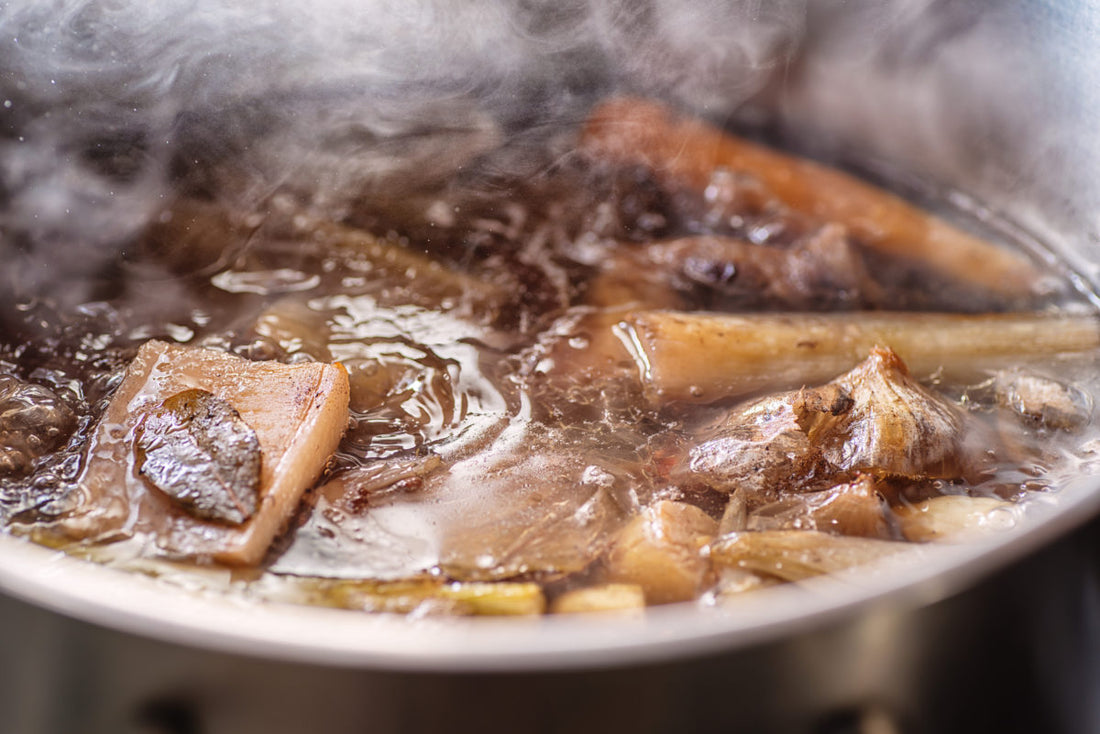Bone broth is a broth made by boiling bones, typically with meat and parts of the animal we typically like to discard (like bone marrow and cartilage). You could add vinegar to help draw out the nutrients, and throw in herbs, spices, and vegetables for even more flavor and nutrients.
Bone broth creates and flavors a variety of dishes. Just think what you would use chicken or beef broth for – bone broth can be used for those things too.
This miraculous dish is not new to our world. In fact, it is a traditional and ancient practice to make bone broth regularly. Growing up in an Asian household, I saw bone broth made often in the house and in restaurants, whether it was for Vietnamese beef noodles, a hearty vegetable soup, or a traditional Chinese dish that required a tasty sauce.
Let’s explore what exactly is in bone broth, its benefits, and what you can make with it.
What is Collagen?
In the bones are many proteins, one of which includes collagen, which forms the inner fibrous part of the bone.
Collagen is a group of amino acids that make up 25-35 percent of our body, found in our bones, skin, joints, ligaments, and tendon. It is the most abundant protein in our bodies, acting as the “glue” that helps hold our bodies together.
As we age, we lose collagen as our bodies naturally slow down its production, which explains why older people experience more joint pain and problems, the loss of skin elasticity, and a slower metabolism. But even younger people can experience these effects through genetic defects, poor intake of collagen-rich foods, digestive problems that affect the production of collagen, or nutritional deficiencies.
Different Types Of Collagen
- Type 1 is found in bone, skin, ligaments, tendons, and the white of the eyes, and makes up 90 percent of the body’s collagen. It is the most abundant and strongest type of collagen found in the human body.
- Type 2 is found in the cartilage and primarily helps build cartilage, which is found in connective tissue. This helps with preventing age-associated joint pain and arthritis symptoms.
- Type 3, also know as reticulin fiber, is found in bone marrow and lymph. It is a major component of the extracellular matrix that makes up our organs and skin. It forms blood vessels and tissue within the heart and helps give skin its elasticity and firmness.
- Did you know that type 4 collagen helps form basal lamina? It’s found in endothelial cells that form tissue surrounding organs, muscles, and fat and are needed for ner and blood vessel functions.
- Type 5 makes the surface of cells, and the hair strands and tissue found in women’s placentas.
- Type 10 collagen helps with forming new bones and articular cartilage, helping heal bone fractures and repair synovial joints.
Why is Collagen Important?
As mentioned earlier, collagen is like the glue that holds everything together – our joints, our skin, muscles, and more. Before diving into the benefits of bone broth, understanding the importance of just one aspect of bone broth (collagen) can give you an early insight into how beneficial it is.
Makes skin supple
A study found that 2.5-5 grams of collagen hydrolysate used with women aged 35-55 every day for eight weeks significantly improved skin elasticity, moisture, transepidermal water loss, and skin roughness – making collagen an effective, natural skin care ingredient.
Helps heal leaky gut
When you have leaky gut, the toxins in your body are able to pass through your digestive tract. Collagen can help break down proteins and soothe your gut’s lining, helping heal damaged cell walls and infusing it with healing amino acids.
It helps form connective tissue and the absorption of water within the intestines to keep things moving more freely out the body. Studies have also found that patients with inflammatory bowel disease have less collagen, showing the use of collagen in our bodies.
Benefits of Bone Broth
Those are just a couple of benefits collagen has, now imagine and explore the type of benefits bone broth has with the other nutrients it contains besides collagen, especially when you add herbs and spices.
Improves joint health
Bone broth is one of the best sources of natural collagen, which we have read above that it is a protein found in vertebrate animals in their bones, skin, cartilage, ligaments, tendons, and bone marrow. With age, comes an increase in joint problems, causing us to naturally experience wear and tear as we become less flexible.
Antibodies attack our cartilage, which causes it to diminish. With the collagen being cooked into a broth, it makes it extremely easy for our body to absorb. Other than collagen, bone broth is also great for gelatin. Gelatin acts as a soft cushion between bones that help the move without friction. It also helps us maintain strong bones and help with healthy bone mineral density.
Helps gut health
We see how collagen helps with leaky gut, similarly, gelatin is beneficial for strengthening the gut lining and fighting food sensitivities (like dairy and wheat), helps the growth of probiotics in the gut, and supports healthy inflammation levels in the digestive tract.
Aids metabolism and promotes anabolism
This broth helps restore glutathione, which studies have shown its usefulness in antioxidant defense, nutrient metabolism, and regulation of cellular activity. A 2004 Journal of Nutrition study stated that glutathione also helps regulate gene expressions, DNA and protein synthesis, cell proliferation, cytokine production, and immune responses.
The glycine found in collagen helps form muscle tissue by converting glucose into energy our bodies can use. On top of that, it slows the loss of muscle, tissue, and cartilage. Studies have shown the protection glycine offers to skeletal muscle loss and stops the expression of genes linked to age-related muscle protein breakdown.
Supports hair, skin, nails, and teeth
The contents (collagen, glycine, glutathione) in bone broth can help reduce the appearance of cellulite, wrinkles, and puffiness, helping maintain our skin’s youthful tone, appearance, and texture.
Other benefits of bone broth include improving cognition, sleep quality, and immune system.

Other Key Nutrients in Bone Broth
Just when you think the list of benefits of bone broth is enough, there’s more! We talked about collagen and briefly mention glutathione, and glycine. Here are a few more nutrients in bone broth we haven’t talked about.
Glycosaminoglycans (GAG)
Glycosaminoglycans’ main function is to support collagen and elastin that are found between bones and fibers. They restore the intestinal lining and are found in bone broth as glucosamine, hyaluronic acid, and chondroitin sulfate.
Glucosamine
The two main types of naturally occurring glucosamine are hydrochloride and sulfate, both of which help maintain cartilage. This helps to provide a natural cushion for our joints. Consuming glucosamine helps with flexibility, comfort, and joint health.
Hyaluronic acid
Hyaluronic acid helps with cell proliferation, differentiation, and mitigation, which allow our cells to perform a variety of functions throughout the body as needed. Like other nutrients in hyaluronic acid, it promotes healthy aging, cell rejuvenation, and skin firmness.
Amino acids
The gelatin found in bone broth contains conditional amino acids that contribute to the drink’s healing properties.
- Arginine – needed for healing wounds, immune system function, the release of growth hormones, regeneration of damaged liver cells, and production of sperm.
- Glycine – prevents the breakdown of protein tissue, makes bile salts and glutathione detoxifies the chemicals in our bodies. It acts as an antioxidant and is a neurotransmitter that improves memory and sleep.
- Proline – helps with regeneration of cartilage, heals joints, reduces cellulite, and repairs leaky gut.
How to Make Bone Broth
- Place bones (from chicken, beef, pork, fish, etc) into a large stock pot and cover with water.
- If using beef or lamb, brown the meat before putting it into the pot.
- Add two tablespoons of apple cider vinegar to water prior to cooking. This helps to pull out important nutrients from the bones.
- Fill stock pot with filtered water. Leave plenty of room for water to boil.
- Heat slowly. Bring to a boil and then reduce heat to simmer for at least six hours. Remove scum as it arises.
- Cook slow and at low heat. Chicken bones can cook for 24 hours. Beef bones can cook for 48 hours. A low and slow cook time is necessary in order to fully extract the nutrients in and around the bone.
- You can also add in vegetables, such as onions, garlic, carrots, and celery, for added nutrient value.
Tell us what you would use bone broth for and how you could personally benefit from it!

 Log in
Log in
